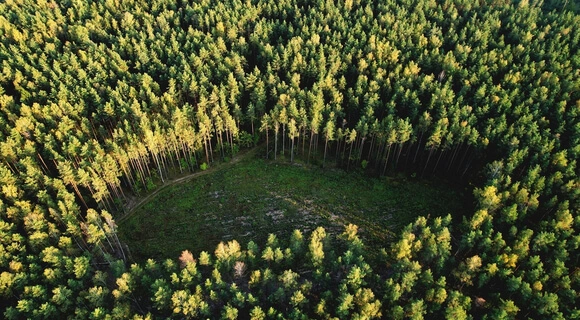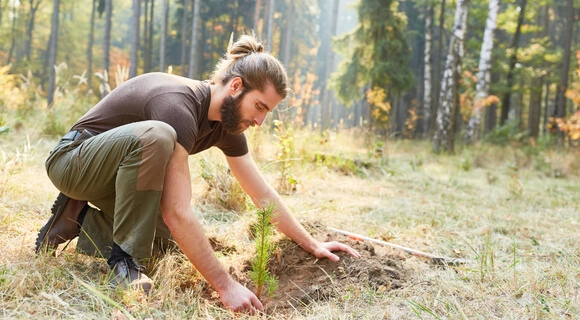
Sustainable Forestry Management & Entailed Practices
Sustainable forestry belongs to highly responsible and thoughtful strategies in forest farming since it preserves forest heritage for years to come. Forests are an invaluable resource, providing oxygen for breathing, habitats for unique species, and a chance for people to earn a living.
Sustainable forestry benefits are multifold and embrace economic, social, and ecological aspects. The implementation of sustainable forestry practices is important as it helps protect forests from conversion to agricultural, urban, and industrial use.
What Is Sustainable Forestry?
As the approach aims at forest preservation, the concept of sustainable forestry supports the very existence of forestlands. This way, mankind still can benefit from forests but has to consume the resource responsibly and restore it in order to be able to do so much longer.
Yes, we can – with preservation, rehabilitation, and reforestation. Apart from adequate management, forest conservation is supported with:
- governmental restrictions and incentives,
- non-governmental initiatives,
- environmental awareness,
- corporate social responsibility.
For example, Oregon was the first U.S. state to ensure continuous forest use. In 1971, the Oregon Department of Forestry issued the Forest Practices Act obliging timber production enterprises to replant trees after harvesting, among the many more forest preservation requirements.
Roundtable on Sustainable Palm Oil (RSPO) is another organization contributing to sustainable forestry. RSPO addresses the problem of palm oil deforestation by demanding commodity certification and zero deforestation in palm oil manufacturers’ supply chains.

Principles Of Sustainable Forest Management
Sustainability in forestry is achieved through weighted decision-making that considers economic, social, and ecological aspects of development. The three aspects work best in combination. If at least one of them is underestimated or overlooked, sustainable forestry implementation won’t be complete.
Nature Protection Principle
Ecologically sustainable forestry responds to environmental concerns caused by deforestation. In particular, environmentally sustainable forest management ensures the following:
- improves air quality thanks to oxygen production and capturing air pollutants by trees;
- decreases biodiversity loss by supporting abundant flora and fauna of forests;
- mitigates climate changes thanks to the accumulation of carbon in the forest soil and trees (dry tree mass is 50% carbon );
- prevents soil erosion by fixing the soil with forest floor and vigorous tree root systems;
- reduces flooding as trees make a natural barrier to water streams and slow them down.

Principle Of Economic Development
Economically sustainable forestry standards correlate tree harvesting with forest preservation and consider the commercial interests of all involved parties. The economic aspect of sustainable forestry improves:
- possibilities of employment;
- rise of the population’s income;
- trade relationships between countries;
- attraction of investments, and more.
Social Development Principle
Socially sustainable forestry methods aim to perform the following tasks:
- improve living standards of local communities that rely on forests for a living;
- offer forestry-related jobs addressing unemployment;
- meet work safety requirements in forests;
- ensure gender and race equity, labor rights, and other social securities.

Sustainable Forest Management Practices
Forest conservation in modern forestry utilizes multiple techniques:
- Afforestation and reforestation enlarge forest areas on our planet.
- The ability to distinguish and treat tree diseases or pest infestations empowers forestry managers to save their farms and mitigate losses.
- Replanting forests after harvesting contributes to ecologically sustainable forestry.
- Selective logging and thinning prevent from felling the entire stand.
- Pruning saves from logging the whole trees for wood and stops pathogens’ spreading.
- Clear-cutting or removal of mature trees contributes to forest health and stimulates offspring growth.
- Controlled burn naturally revives forests – on condition the process does not go beyond control.
- Specific training boosts foresters’ proficiency in sustainable forestry techniques.
- Weighted planning facilitates the solutions for more sustainable forestry.
- Satellite forest monitoring enables remote control of the forest state and timely response to deviations.
There is no universal recipe for every forest, and the list goes far beyond the above-mentioned practices. Each forestry management technique should consider commercial value, forest specifics, environmental aspects, communities’ needs, and stakeholders’ interests. Besides, the collaboration of forestry managers with local businesses, authorities, NGOs promotes more effective decision-making.

Continuous Monitoring Of Forest Stands As A Sustainable Forestry Practice
Regular inspection determines an effective forest farm run. Yet, this is not always feasible, especially when it comes to vast, distant, or hard-to-reach locations. It is where remote sensing is particularly handy. Satellite monitoring is among the most effective forest management practices allowing foresters to greatly improve their businesses.
EOSDA has developed the EOSDA LandViewer software to facilitate foresters’ efforts – a smart tool for remote forest control and forestry management. In particular, EOSDA LandViewer users can enjoy the following:
- monitor forest stands remotely;
- assess overall forest health;
- track changes and receive regular problem area alerts;
- detect and report illegal logging and forest fragmentation with satellite-based deforestation maps;
- compare planned and actual tree felling scope;
- control forest regrowth;
- analyze AOIs before and after deforestation, and more – all in one place.
EOSDA LandViewer eases foresters’ efforts to upkeep and regenerate forests, thus improving sustainable forest management practices. Please, contact our sales department for details on EOSDA LandViewer features at sales@eosda.com.
Why Is Sustainable Forestry Important?
The significance of sustainable forestry is explained with the forest benefits for all living beings on our planet. Thus, sustainable forest management benefits are the same as forest benefits as such, with the important difference that people can enjoy them for a long time.
Despite all sustainable forestry advantages, global deforestation rates are alarming, especially in the tropical latitudes, and the biggest threat to forestlands is agriculture. Around 80% of deforestation in the world occurs for the sake of farming.
The impact is the most severe in Latin America, Africa, and Asia due to palm oil, soybean, or beef production. It is why sustainable forest management in developing countries summons particular attention.
Modern Sustainable Forestry Implementation
Permanent availability of forest benefits essentially depends on sustainable forestry management facilitated with remote sensing. However, much depends on regular people, too. So, raising public awareness encourages a sparing and responsible attitude to forests, contributing to nature protection. Paid employees and volunteers replant billions of trees worldwide in the U.S., Pakistan, China, Africa, and other countries.
Joint efforts of forestry managers, governments, ecologists, and communities can remarkably improve forest conservation. Satellite monitoring is capable of promoting this noble mission by guarding the forest heritage and tracking tree growth.
About the author:
Kateryna Sergieieva has a Ph.D. in information technologies and 15 years of experience in remote sensing. She is a Senior Scientist at EOSDA responsible for developing technologies for satellite monitoring and surface feature change detection. Kateryna is an author of over 60 scientific publications.
Recent articles

Analyze 2025 & Plan Your Best Year Yet: LandViewer Christmas Offer
It’s the most wonderful time of the year! The Christmas holidays are here, and so is your chance to analyze 2025 and plan a prosperous 2026 with more affordable Pro plans in LandViewer.

EOSDA Models Climate Change Impact On Sugarcane Yields
EOSDA modeled future temperature, rainfall, and other climate impacts on Veracruz sugarcane. The results help growers plan long-term adaptation strategies, including timing, varieties, and irrigation.

EOSDA LandViewer Black Friday Sale: Exclusive Offers & Giveaway
This Black Friday, LandViewer offers new users the chance to save on monthly plans, get extra months with yearly subscriptions, and participate in a free annual plan giveaway.

